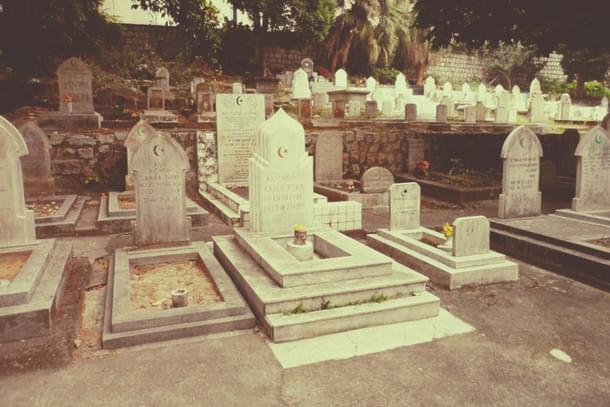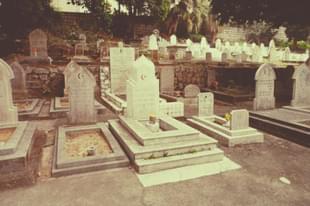Ideas
Kabaristans Are Running Out Of Space Due To Covid-19; It’s Time To Overhaul Our Policies On Burials
Arihant Pawariya
Jun 19, 2020, 01:57 PM | Updated 01:57 PM IST
Save & read from anywhere!
Bookmark stories for easy access on any device or the Swarajya app.


What chance could the dead have of securing a place in cities when unbridled and rampant urbanisation has made it difficult for most people to afford even living there.
Across the world, graveyards, at least in major metros, were already running out of space. Covid-19, the disease caused by the novel coronavirus, has made the situation grave. As the virus spreads through the population, the bodies are piling up left, right and centre (quite literally) and burial grounds which were already under pressure are now showing signs of strain.
As per a report published in 2018 by Delhi Minorities Commission, a sectarian organisation funded by taxpayers, there was space enough to bury only 30,000 more people. Yearly, Muslim burials alone are more than 13,000. Similar situation prevailed in other Indian metros like Mumbai, Chennai, Kolkata, Hyderabad, Bengaluru, etc.
Given that these cities are also one of the biggest victims of the epidemic and Muslims are being disproportionally hit for various reasons, burial grounds will run out of space quicker than previously estimated.
Kabristans at Mulla Colony and Bulland Masjid that come under East Delhi municipal corporation are now refusing to accommodate the dead. Delhi Gate cemetery which is sitting on 50 acres of the poshest land in the national capital and which has buried over 300 people under Covid-19 protocol has space for just 150 more graves.
It’s not just big metros like Delhi or Mumbai that are facing the ‘grave‘ crisis. Kabristans designated for burying the Covid-19 victims in tier 2 cities like Vadodara are also reporting shrinking capacity.
Less land availability makes burial a costly affair (price for permanent graves can be as high as Rs 50,000). Thanks to this, Christians in some places are now increasingly opting for cremation. In the United States which is an overwhelmingly Christian majority country, more than half of the dead are cremated rather than buried.
But space is not the only factor that contributes to high cost of burial.
Other factors like embalming, type of coffin, transportation, etc can also jack up the overall price of a funeral. This means spending anywhere between a few thousands to even lakhs of rupees.
In a poor country like India, such monetary burden can be debilitating to one’s finances.
Then how do Muslims and Christians find more land for creating burial grounds?
The graveyards are usually owned by community boards or members of communal organisations.
Since there is always demand of these communities for more land, the community leaders approach the politicians in power to allot them more land. The ’secular’ parties normally comply with such ‘requests’ and direct the powers that be in municipality to give certain area for burials.
Another method is encroachment on public land by Muslim organisations which invites the accusations of ‘land jihad’ from Hindu organisations.
Such encroachments aren’t cleared for fear of upsetting the minority vote bank. True or not, all this leads to unnecessary division and animosity between communities.
Nonetheless, the Indian state needs to rethink its policies regarding burial grounds.
To solve the problems of shrinking space, rising costs of burials affecting poor people adversely, communal tensions arising out of encroachment, etc, the government needs to do these five things.
First, it needs to nationalise all burial grounds and should have a policy of not allowing any privately owned graveyards in the future.
However, their management can be contracted out to non-governmental organisations including the private sector firms and the prices of burials can be capped.
Second, all the cemeteries that are now full, and which do not have permanent or marked graves, should be converted into wildlife sanctuaries or public parks/playgrounds or to supplement other public infrastructure lacking in the area where they are located.
The graveyards which are not full should be developed into modern burial grounds with focus on efficient utilisation of limited space. This can include multi-storey burial buildings with basements and high-rises.
Other alternative is having a vault system where cells are created in a sphere-shaped wall structure with a pit at the centre and as the bodies decompose, the remains can be pushed into the pit (some cemeteries in New Delhi already follow this model).
This means that a small burial ground can be in use for a long period of time and there is no need for the government to constantly allot land for graveyards.
Third, permanent graves should be disallowed everywhere. All burials should be green meaning that embalming chemicals should be outlawed along with burying the dead using cement, steel or other non-biodegradable materials. Chemical treatments of corpses that allows for its quick decomposition should be made mandatory.
Fourth, no communal burial ground should be allowed. Since the government will own all the graveyard land, members of all communities — Muslims, Christians or Hindu communities which bury their dead — will have access to these spaces.
No communal organisation like the state waqf boards, mosques, churches, or other Islamic/Christian/Hindu organisations should have ownership rights over the burial grounds.
But if Muslims and Christians want to insist on separate graveyards then the government can take over waqf or church property available in the area and convert it into a burial ground.
Fifth, the government should promote cremation of the dead among non-Hindu communities also. Christians are already doing it not just in India but across the world.
The practice should be promoted among Muslims as well. Cremation practices also need to be made more environment friendly. A lot of innovation is already happening on that front.
Other environment-friendly methods such as freezing drying corpses to convert into fertilisers, turning them into artificial coral reefs or handing over bodies for medical research can also be encouraged.
Covid-19 presents a good opportunity for the government to solve the emerging crisis of shrinking burial space especially in our big cities. It must seize the moment and not let this go to waste.
Arihant Pawariya is Senior Editor, Swarajya.




